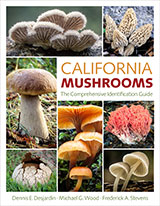The North American Species of Pholiota
17. Pholiota subechinata sp. nov.
Pileus 10-25 mm latus, late convexus, siccus, fibrilloso-squamulosus, fulvus. Lamellae latae, subdistantes, adnatae, luteae demum fulvae. Stipes 2.5-3.5 cm longus, 1.5 mm crassus, flexilis, subluteus, deorsum fulvus. Sporae 7-9 x 4-4.5 µ. Pleurocystidia desunt. Cheilocystidia 26-40 (50) x 8-16 µ, subclavata. Specimen typicum in Herb. Univ. Mich. conservatum est; legit prope Mt. Adams, Wash. 19 Oct. 1954, Smith 49291.
Pileus 10-25 mm broad, convex to convex-depressed, surface dry and minutely fibrillose-squamulose, squamules erect over disc and more appressed near the margin, tawny to darker rusty brown. Context yellowish, thin, fairly lax, odor none, taste not recorded.
Lamellae broad, subdistant, adnate, seceding, dull yellow young, darker fulvous than pileus when mature, edges flocculose. Stipe 2.5-3.5 cm long, 1.5 mm thick, equal, fairly pliant, dull yellowish above, soon dark fulvous from the base up (over all as dried), thinly coated to the evanescent veil-line from the remnants of the veil, with a pad of yellowish mycelium at base.
Spores 7-9 x 4-4.5 µ, smooth, germ pore very minute, dingy ochraceous in Melzer's reagent, in KOH cinnamon, oblong to elliptic in face view and some obscurely angular, somewhat to distinctly bean-shaped in profile.
Basidia 4-spored, 22-30 x 5-7 µ, yellowish hyaline in KOH, narrowly clavate. Pleurocystidia none. Cheilocystidia 26-40 (50) x 8-16 µ mostly somewhat enlarged at apex (the widest part) but apex varying from rounded to truncate or subacute, rarely bifurcate, walls thin, smooth and hyaline in KOH (reminding one of those of P. erinaceella but not as capitate). Caulocystidia with rusty cinnamon thin walls usually smooth, 35-60 x 8-12 µ, fusoid to boomerang-shaped, terminal or arising laterally from hyphae of stipe cortex.
Gill trama regular, of yellowish to brownish hyphae with smooth scarcely thickened walls; subhymenium not distinctive. Pileus cutis a trichodermium of hyphae mostly with short broad cells (1-2 times as long as broad), the walls slightly thickened or thin and many with coarse plates of incrusting material, in KOH dark red (near "Bay"), end-cells subglobose to elliptic or ovate. Clamp connections present. All tissues inamyloid.
Habit, Habitat, and Distribution: On a conifer log, on the upper Cispus River, Washington, near Mt. Adams, Oct. 19, 1954, Smith 49291 (type).
Observations: The sphaerocyst-like cells in the trichodermial hyphae of the pileus would seem to indicate stirps Aurea. However, no disarticulation of the cells was noted. The caulocystidia are unique as known to date in this subgenus, but need further study in relation to veil elements. The diagnostic features of this species are the habitat on conifer logs, the coarse pigment deposits on at least a fair number of the trichodermial hyphae and the large number of subglobose cells in many of the hyphae, the cheilocystidia of the P. erinaceella type, and the broad subdistant gills. The conifer-inhabiting members of this section in North America are rare and occur solitary. There are more than those described here, but our data on them are very incomplete. Some might be inclined to regard P. subechinata as a synonym of P. muricata but the latter is said to occur on beech, have a densely fibrillose stipe below the veil-line, and nothing is said of the gills spotting rusty as in Gymnopilus species. P. subechinata has a thin fibrillose veil leaving only inconspicuous scattered patches on the stipe, the gills become rusty spotted, and the ornamentation of the pileus is not granulose. Because of these possible differences we believe it wiser to consider the conifer inhabiting fungus as a different species. It is readily distinguished from P. granulosa by its cheilocystidia. In the latter they are mostly short-clavate to ovate.

